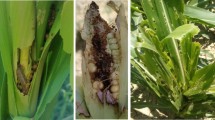Abstract
Little is known regarding non-chemical control measures againstThrips palmi Karny. Since entomopathogenic fungi and nematodes have been found to be active against thrips species such asFrankliniella occidentalis Pergande, comparative bioassays were conducted to determine the extent to which they also show activity againstT. palmi. Significant mortality of the larvae of the species was recorded following treatment withLecanicillium muscarium (Petch) Zare and Gams, and addition of the wetting agent Agral enhanced pathogenicity toT. palmi. T. palmi pupae were not affected byS. feltiae. The potential for use of these agents againstT. palmi in the field is discussed in the light of these results.
Similar content being viewed by others
References
Azaizeh, H., Gindin, G., Said, O. and Barash, L. (2002) Biological control of the western flower thripsFrankliniella occidentalis in cucumber using the entomopathogenic fungusMetarhizium anisopliae.Phytoparasitica 30:18–24.
Candy, S.G. (2003) Predicting time to peak occurrence of insect life-stages using regression models calibrated from stage-frequency data and ancillary stage-mortality data.Agric. For. Entomol. 5:43–49.
Chyzik, R., Glazer, I. and Klein, M. (1996) Virulence and efficacy of different entomopathogenic nematode species against western flower thrips (Frankliniella occidentalis).Phytoparasitica 24:103–110.
Cuthbertson, A.G.S., Head, J., Walters, K.F.A. and Gregory, S.A. (2003) The efficacy of the entomopathogenic nematode,Steinernema feltiae, against instars ofBemisia tabaci.J. Invertebr. Pathol. 83:267–269.
Cuthbertson, A.G.S., Head, J., Walters, K.F.A. and Murray, A.W.A. (2003) The integrated use of chemical insecticides and the entomopathogenic nematode,Steinernema feltiae, for the control of sweetpotato whitefly,Bemisia tabaci.Nematology 5:713–720.
Cuthbertson, A.G.S., Walters, K.F.A. and Deppe, C. (2005) Compatibility of the entomopathogenic fungusLecanicillium muscarium and insecticides for eradication of sweetpotato whitefly,Bemisia tabaci. Mycopathologia 160 (in press).
Ebssa, L., Borgemeister, C. and Poehling, H-M. (2001) Impact of entomopathogenic nematodes on different soil dwelling stages of western flower thrips,Frankliniella occidentalis (Thysanoptera: Thripidae), in the laboratory and under semi-field conditions.Biocontrol Sci. Technol. 11:515–525.
Ebssa, L., Borgemeister, C. and Poehling, H-M. (2004) Effectiveness of different species/strains of entomopathogenic nematodes for control of western flower thrips (Frankliniella occidentalis) at various concentrations, host densities, and temperatures.Biol. Control 29:145–154.
Ebssa, L., Borgemeister, C., Semrau, J. and Poehling, H-M. (2004) Efficacy of entomopathogenic nematodes against western flower thripsFrankliniella occidentalis at different pupation depths.Nematology 6:495–505.
Ekesi, S., Maniania, N.K., Onu, I. and Löhr, B. (1998) Pathogenicity of entomopathogenic fungi (Hyphomycetes) to the legume flower thrips,Megalurothrips sjostedi (Trybom) (Thysan., Thripidae).J. Appl. Entomol. 122:629–634.
Fan, X. and Hominick, W.M. (1991) Efficiency of theGalleria (wax moth) baiting technique for recovering infective stages of entomopathogenic rhabditids (Steinernematidae and Heterorhabditidae) from soil and sand.Rev. Nematol. 14:381–387.
Helyer, N.L., Brobyn, P.J., Richardson, P.N. and Edmondson, R.N. (1995) Control of western flower thrips (Frankliniella occidentalis Pergande) pupae in compost.Ann. Appl. Biol. 127:405–412.
Kirk, W.D.J. (1997) Feeding.in: Lewis, T. [Ed.] Thrips as Crop Pests. CAB International, Wallingford, UK. pp. 119–174.
Kirk, W.D.J. and Terry, L.I. (2003) The spread of the western flower thripsFrankliniella occidentalis (Pergande).Agric. For. Entomol. 5:301–310.
McDonald, J.R., Bale, J.S. and Walters, K.F.A. (1997) Low temperature mortality and overwintering of the western flower thripsFrankliniella occidentalis (Thysanoptera: Thripidae).Bull. Entomol. Res. 87:497–505.
McDonald, J.R., Bale, J.S. and Walters, K.F.A. (1999) Temperature, development and establishment potential ofThrips palmi (Thysanoptera: Thripidae) in the United Kingdom.Eur. J. Entomol. 96:169–173.
Premachandra, D.W.T.S., Borgemeister, C., Berndt, O., Ehlers, R-U. and Poehling, H-M. (2003) Laboratory bioassays of virulence of entomopathogenic nematodes against soil-inhabiting stages ofFrankliniella occidentalis Pergande (Thysanoptera: Thripidae).Nematology 5:539–547.
Saito, T. (1991) A field trial of an entomopathogenic fungus,Beauveria bassiana (Bals.) Vuill., for the control ofThrips palmi Karny (Thysanoptera: Thripidae).Jpn. J. Appl. Entomol. Zool. 35:80–81.
Tsai, J.H., Yue, B., Webb, S.E., Funderburk, J.E. and Hsu, H.T. (1995) Effects of host plant and temperature on growth and reproduction ofThrips palmi (Thysanoptera: Thripidae).Environ. Entomol. 24:1598–1603.
Ullman, D.E., Sherwood, J.L. and German, T.L. (1997) Thrips as vectors of plant pathogens.in: Lewis, T. [Ed.] Thrips as Crop Pests. CAB International, Wallingford, UK. pp. 539–566.
Urano, S., Shima, K., Hirose, Y., Nagai, K., Ohno, K., Takemoto, H.et al. (2003) Biological control ofThrips palmi (Thysanoptera: Thripidae) with the predatory bug,Wollastoniella rotunda (Hemiptera: Anthocoridae) on greenhouse eggplant in winter.J. Fac. Agric. Kyushu Univ. 47:325–331.
Vestergaard, S., Gillespie, A.T., Butt, T.M., Schreiter, G. and Eilenberg, J. (1995) Pathogenicity of the Hyphomycete fungiVerticillium lecanii andMetarhizium anisopliae to the western flower thrips,Frankliniella occidentalis.Biocontrol Sci. Technol. 5:185–192.
Williams, E.C. and Walters, K.F.A. (2000) Foliar application of the entomopathogenic nematode,Steinernema feltiae against leafminers on vegetables.Biocontrol Sci. Technol. 10:61–70.
Zare, R. and Gams, W. (2001) A revision ofVerticillium section Prostrata. IV. The generaLecanicillium andSimplicillium gen. Nov.Nova Hedwigia 73:1–50.
Zhao, G., Liu, W., Brown, J.M. and Knowles, C.O. (1995) Insecticide resistance in field and laboratory strains of western flower thrips (Thysanoptera: Thripidae).J. Econ. Entomol. 88:1164–1170.
Author information
Authors and Affiliations
Corresponding author
Additional information
http://www.phytoparasitica.org posting Aug. 28, 2005.
Rights and permissions
About this article
Cite this article
Smith, R.M., Cuthbertson, A.G.S. & Walters, K.F.A. Note: Extrapolating the use of an entomopathogenic nematode and fungus as control agents forFrankliniella occidentalis toThrips palmi . Phytoparasitica 33, 436–440 (2005). https://doi.org/10.1007/BF02981392
Received:
Accepted:
Issue Date:
DOI: https://doi.org/10.1007/BF02981392




